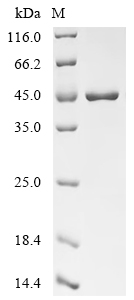Recombinant Human Histone-lysine N-methyltransferase SETDB1 (SETDB1)
CAT:
399-CSB-EP619960HUe1-03
Size:
1 mg
Price:
Ask
- Availability: 24/48H Stock Items & 2 to 6 Weeks non Stock Items.
- Dry Ice Shipment: No




Recombinant Human Histone-lysine N-methyltransferase SETDB1 (SETDB1)
- CAS Number: 9000-83-3
- Gene Name: SETDB1
- UniProt: Q15047
- Expression Region: 1-397aa
- Organism: Homo sapiens
- Target Sequence: MSSLPGCIGLDAATATVESEEIAELQQAVVEELGISMEELRHFIDEELEKMDCVQQRKKQLAELETWVIQKESEVAHVDQLFDDASRAVTNCESLVKDFYSKLGLQYRDSSSEDESSRPTEIIEIPDEDDDVLSIDSGDAGSRTPKDQKLREAMAALRKSAQDVQKFMDAVNKKSSSQDLHKGTLSQMSGELSKDGDLIVSMRILGKKRTKTWHKGTLIAIQTVGPGKKYKVKFDNKGKSLLSGNHIAYDYHPPADKLYVGSRVVAKYKDGNQVWLYAGIVAETPNVKNKLRFLIFFDDGYASYVTQSELYPICRPLKKTWEDIEDISCRDFIEEYVTAYPNRPMVLLKSGQLIKTEWEGTWWKSRVEEVDGSLVRILFLVLFFSTILEAEVGGGGT
- Tag: Tag-Free
- Source: E.coli
- Field of Research: Epigenetics and Nuclear Signaling
- Assay Type: In Stock Protein
- Relevance: Histone methyltransferase that specifically trimethylates 'Lys-9' of histone H3. H3 'Lys-9' trimethylation represents a specific tag for epigenetic transcriptional repression by recruiting HP1 (CBX1, CBX3 and/or CBX5) proteins to methylated histones. Mainly functions in euchromatin regions, thereby playing a central role in the silencing of euchromatic genes. H3 'Lys-9' trimethylation is coordinated with DNA methylation. Required for HUSH-mediated heterochromatin formation and gene silencing. Forms a complex with MBD1 and ATF7IP that represses transcription and couples DNA methylation and histone 'Lys-9' trimethylation. Its activity is dependent on MBD1 and is heritably maintained through DNA replication by being recruited by CAF-1. SETDB1 is targeted to histone H3 by TRIM28/TIF1B, a factor recruited by KRAB zinc-finger proteins. Probably forms a corepressor complex required for activated KRAS-mediated promoter hypermethylation and transcriptional silencing of tumor suppressor genes (TSGs) or other tumor-related genes in colorectal cancer (CRC) cells. Required to maintain a transcriptionally repressive state of genes in undifferentiated embryonic stem cells (ESCs). In ESCs, in collaboration with TRIM28, is also required for H3K9me3 and silencing of endogenous and introduced retroviruses in a DNA-methylation independent-pathway. Associates at promoter regions of tumor suppressor genes (TSGs) leading to their gene silencing. The SETDB1-TRIM28-ZNF274 complex may play a role in recruiting ATRX to the 3'-exons of zinc-finger coding genes with atypical chromatin signatures to establish or maintain/protect H3K9me3 at these transcriptionally active regions.
- Purity: Greater than 85% as determined by SDS-PAGE.
- Activity: Not Test
- Bioactivity: Not Test
- Length: Full Length of Isoform 2
- Form: Liquid or Lyophilized powder
- Buffer: If the delivery form is liquid, the default storage buffer is Tris/PBS-based buffer, 5%-50% glycerol. If the delivery form is lyophilized powder, the buffer before lyophilization is Tris/PBS-based buffer, 6% Trehalose, pH 8.0.
- Reconstitution: We recommend that this vial be briefly centrifuged prior to opening to bring the contents to the bottom. Please reconstitute protein in deionized sterile water to a concentration of 0.1-1.0 mg/mL.We recommend to add 5-50% of glycerol (final concentration) and aliquot for long-term storage at -20℃/-80℃. Our default final concentration of glycerol is 50%. Customers could use it as reference.
- Molecular Weight: 44.8 kDa
- Storage Conditions: The shelf life is related to many factors, storage state, buffer ingredients, storage temperature and the stability of the protein itself. Generally, the shelf life of liquid form is 6 months at -20℃/-80℃. The shelf life of lyophilized form is 12 months at -20℃/-80℃.
